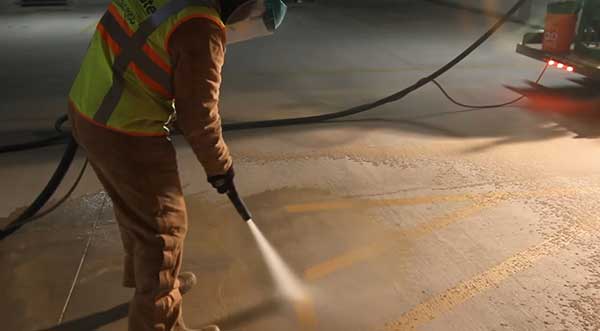Sandblasting Block Wall
Sandblasting Block Wall
Benefits of Sandblasting Block Walls
Durability
One of the greatest advantages of sandblasting block walls is durability. Unlike painting or other methods, sandblasted walls are not prone to peeling, chipping, fading, or cracking over time. This ensures that your block wall looks just as good years down the line as it did when it was first installed. In addition, sandblasted walls are highly resistant to weathering and will last much longer than untreated surfaces.

Cost-Effective
Another significant benefit of sandblasting block walls is cost-effectiveness. Sandblasting requires minimal preparation time and no additional supplies beyond traditional methods such as painting or staining. As a result, this method can be completed in less time and with fewer resources than other treatments for exterior walls. Additionally, sandblast finishes can withstand harsh conditions better than other treatments.
Eco-Friendly
Sandblasted block walls are also highly eco-friendly for cleaning and refinishing exterior surfaces. Sandblast materials do not contain any chemicals or toxins which could harm local wildlife after being washed off with rainwater runoff from your property’s roofing system. Furthermore, since there is no need to use harsh solvents during this process—and no paint used—your carbon footprint will be substantially reduced compared to other methods, such as painting or staining exterior surfaces with toxic finishes.
Steps to Follow When Performing Sandblasting on a Block Wall
Step 1: Prepare the Surface
The first step in sandblasting is to prepare the surface for blasting. This includes cleaning off any dirt or debris that may have accumulated on the surface of the block wall. Additionally, you will want to repair any cracks or holes that may be present in the wall. You should also make sure the surface is dry before you begin sandblasting.
Step 2: Select Your Blasting Material
Once your surface is prepped and ready for blasting, it’s time to select your blasting material. The type of material you choose will depend on what texture and design you want to achieve with your project. For example, sand would be a good choice if you are going for a smooth finish; however, if you are looking for a rougher texture, walnut shells would be better suited for this purpose.
Step 3: Set Up Your Blasting Equipment
Once you have selected your blasting material, it’s time to set up your blasting equipment. This includes selecting an appropriate air compressor with enough pressure for your job (typically 90-100 psi). Additionally, you will need an abrasive gun connected via an air hose and a nozzle connected directly to your compressor. Make sure all connections are secure before starting your job!
Step 4: Begin Blasting
Now it’s time to begin blasting! Be sure to wear all necessary safety gear, such as goggles and gloves, while operating the equipment. Gradually move across the entire surface of the block wall while applying moderate pressure at all times. Once finished, let the blasted area dry completely before proceeding with any additional work or painting.
Sandblasting can be used effectively on block walls to remove old paint or debris while providing an opportunity for creative expression through texture and design creation. Following these steps carefully ensures that your project turns out just as you envisioned it!
Choosing the Right Sandblasting Contractor for Your Block Wall Project
Selecting the right contractor is essential if you’re planning to sandblast a block wall. The sandblasting process is difficult and time-consuming, so finding someone with the right experience and skillset is necessary. We’ll look at how to choose a contractor for sandblasting your block wall project.
Research and Evaluate Potential Contractors
The first step in choosing a contractor for your sandblasting project is researching potential contractors. Look online for reviews from previous customers and ask around in your local community for recommendations. Once you have identified several potential contractors, evaluate them based on their experience, qualifications, references, and pricing structure. Make sure that they are properly licensed and insured as well.
Communicate Your Goals
Once you have narrowed down your list of potential contractors, it’s important to communicate your goals for the project. Ask questions about the tools and materials used during the process and how long you can expect the project to take. Be sure to discuss any safety concerns you may have regarding using hazardous materials like lead or asbestos during the sandblasting process.
Negotiate Payment Terms
After settling on a contractor, it’s time to negotiate payment terms. This is essential because it will help ensure everything is predictable when it comes time to pay for the project. Talk with your contractor about payment options such as hourly rates, flat fees, or progress payments throughout different stages of the completion of your project. Ensure both parties understand what is expected before signing contracts or making payments.
Selecting a contractor for sandblasting your block wall project should be taken seriously; you must consider many factors before committing to a particular company or individual. By researching potential contractors, communicating your goals clearly, and negotiating payment terms beforehand, you can ensure that you choose a professional best suited for handling your specific needs and desires on this job.
Whether you’re looking to restore an old building’s facade or improve the look of a newly constructed one, sandblasting block walls may be an excellent choice for achieving your desired results quickly and cost-effectively while still being environmentally conscious in the process.
